#that sara is the catalyst of all len's changes
Explore tagged Tumblr posts
Note
Couldn't the changes in Len's character in Legends be due to how he fell for Sara? With the one deleted scene they released it looked like it was almost love at first sight. He was kinder and more honest and open with her than anyone else including Lisa and Mick. No one saw through and understood him like she did ever before. His getting rid of Mick was more about him trying to hurt Sara than the team. And she was the one who got him to make up with Mick. It never would have happened without her
Anon, there is so much wrong here that I very strongly considered not answering because the only things I can say are to disagree with you and that’ll probably make you angry.
But, well, I was a little angry too, particularly at the line “His getting rid of Mick was more about him trying to hurt Sara than the team” but I decided not to let anger rule my thoughts. Nonetheless, I’m gonna answer because I feel it’s worth a discussion for why I think differently, and why your post struck a bit of a nerve. Sorry if this isn’t what you want to hear, but I really do feel it warrants a meta/commentary response.
First, no I don’t think all the changes in him are due to Sara and I’d say that’s an oversimplification of how and why a person changes. It strips Len of those changes being about him at all really, taking away some of his autonomy in making the changes. If you change solely for someone else and not for yourself, that’s not sustainable. Len changed for himself and through the influence of a host of different factors, and to reduce it to largely one thing misses so much of the complexity of how and why people change in reality. And I’m not saying that falling in love can’t change a person (through the different viewpoints they take on and through the trust they develop), but I also don’t read Len as having been in love with Sara. People, a single person, can help catalyze change in us even without being in love, of course, but it’s still missing some of the point to make it all about that other person. Change happens internally.
And there are a lot of the factors that could plausibly, canonically, go into him changing. I mean, I maintain that many of the changes that bothered me (the very subtle characterization ones that tilt him more to a slytherin-hufflepuff than a slytherin-ravenclaw) are ones that came in from the writers wanting to have him work with a team and taking over his character from a different team, losing a bit in translation. But in canon, if we try to explain those changes, I really would not ever want to attribute them to solely one character.
I feel that if we explain the canonical changes in Len, we can point to a couple of major factors, and his budding friendship with Sara is one of those (because it shows him letting people in and believing that change and overcoming one’s past is actually possible, because it’s something she is doing and demonstrating). A few others are Barry’s staunch belief in Len’s goodness and his willingness to help Len, working with Lisa and Mick again and the effect that has on him, being free of his father in a final way, and working with a team of people who’s wellbeing he feels responsible for (especially Jax). I’ve made posts that talk about most of those factors in one way or another though, so I won’t delve into them here.
More specific to the points you raise, I disagree that he demonstrates anything approaching love at first sight in the deleted scene.
youtube
Honestly the only thing I read into that is that he a) is trying to get a feel for people on the team and doesn’t quite know what to make of Sara yet, except that she might be the only one aside from Mick he has anything in common with (she shuts that down with the reincarnated point), and b) that he’s a bit intrigued at her willingness to bite back, but maybe a little annoyed at how barbed she is with him. (For the record we literally never see him even glance in the direction of her ass so I don’t get where that line is from.)
I also strongly disagree that he’s “kinder and more honest and open with her than anyone else including Lisa and Mick”. I don’t even know where you get that idea, to be frank. Len loves his sister to death and would do anything for her. He would never raise a weapon to her like he does to Sara in 1x15 and there’s zero reason to suspect he’d be less honest with her than with Sara (or anyone else). If you try to raise the point that he didn’t tell her his dad kidnapped him, I’d counter by saying he didn’t really have a chance and wanted to protect her. He also happened to lie to Sara (alongside the rest of the team) about having killed Mick.
If you want to talk about Len opening up about his past to people like his heart-to-heart with Sara while they were freezing to death, he’s even similarly expository with Ray (who I maintain he ultimately dislikes) without much prompting.

Len also lies to Sara’s face at least once or twice, particularly about Mick. “Everyone okay between you two?” “Peachy.” Even if it’s unbarbed and obvious, he’s not really being honest (with himself or with her, and they both know it). He’s not opening up to her.

With Mick, Len is admittedly not always honest, or fair.

But that’s in part because he takes a high degree of responsibility for Mick, maybe more than Mick wants him to. He doesn’t always expect Mick to make decisions in his own best interest, and Len has a very high need for control and believes he’ll make the best decision for his friend.

Is it okay? Not necessarily. But I don’t think he means that he’s largely dishonest with Mick or that there isn’t a huge amount of trust and understanding between them.
Mick’s the one who knows Len’s intentions for going in the trip, knows where Len’s head is at, is the one at Len’s side who can literally finish his sentences and move in sync with him. They have one-word codes like ‘Alexa’ and ‘like that time in Chicago’ that tell them everything they need to know about a situation. 30+ years of history will do that with someone.
Actually, the whole ‘pulling the cold gun out’ thing is neat with respect that. He pulls it on Mick, Mick pulls the heat gun out, they have a stand off for a minute. Len appears to think about it and calm down and come up with the next step for what to do, or else it gives him space to remember to be the reasonable one. Mick gets this too because he doesn’t ever pull his trigger, just waits for Len to decide to end the stand off, every time we’ve seen them have one. But with Sara, she called his bluff. She didn’t understand why he’s doing this and what he gets out of pulling out his gun and having a stand off with someone so she calls him on it (which is fair, I’m not saying she’s in the wrong). And maybe it’s all dysfunctional as hell of him, but I think it demonstrates how Mick understands Len better than Sara does. He moves along to the beats Len is playing in a way that Sara won’t (which is fine because no one needs to, but you can’t tell me that Mick doesn’t understand Len inside and out, up and down).
Which is why I so strongly shirk at the idea that Len ‘got rid of Mick’ (just that in the first place, he didn’t get rid of him), more for Sara than for anyone else. Len marooned Mick for the stated reason of worrying what would happen to his sister if Mick went back to 2016. He knows Mick has impulse control problems and anger issues. He knows that he himself acts like a check/balance on Mick, so dropping him off in 2016 could have some high-damage consequences. So it was about protecting the team, and protecting their loved ones in 2016 (particularly Lisa, the person Mick is most likely to go after because it’s more Len he wants revenge on than any of the other team members). Beyond that canonically-stated reason for marooning Mick, it could also have come down to a lot of personal shit between Len and him.
To the extent that once he chose not to kill him, Len always planned to return for Mick (till death got in the way), he probably intended for the marooning to be a very short cool-down period for Mick before Len picked up back up and brought him home. A “okay you betrayed us you jackass and it fucking hurt and I’m pissed but I’ve had time to think about it and you’ve been stuck here to think about it for a day, so now let’s go home alright?”.
I mean, you can read a lot more into it than that with respect to their relationship, but I don’t think it’s valuable to bring anyone else into that. It was about Len and Mick, and to a lesser extent about Lisa, and then about the team as a unit. There’s no evidence it was about anyone else, and certainly no evidence that Len was worried Mick would hurt Sara if he stuck around.
As for her being the reason they made up, I agree she had a part in that, but I also think it would have happened eventually in the same way regardless. She was a catalyst though, and showed empathy and deep understanding in that situation. I think that’s highly to her credit, actually, and I’m not sure why you’d make that about Len’s character changes when it really shows her own development and insight.
But Len and Mick have been at serious odds before, were apart for a few years even, and still manage to find their way back to one another. They always do, with or without anyone’s help, and being confined on a ship together was going to press the issue sooner rather than later. Sara didn’t convince Len to lay down his life for Mick and die if that’s what Mick wanted from him. Len’s love for Mick did that, full stop.


tl;dr - Mick and Lisa understand Len better than Sara does as per canon, and he canonically demonstrates more honesty with his sister and more mutual understanding with Mick than he does with her. There’s nothing to suggest love at first sight (intrigue, at most) and there’s nothing at all to suggest that him marooning Mick had anything to do with Sara herself. The implication Len changed solely/mostly because of her is just a large oversimplification that strips him of personal autonomy in making those changes.
#leonard snart#captain cold#anti captain canary#i don't honestly hate the ship#but i really hate the implication#that sara is the catalyst of all len's changes#and the idea that she's more important to him than mick or lisa#the people clearly stated as most important in the world to him#characterization#legends of tomorrow#lot commentary#commentary#phyn rants#sorry anon#but you struck a nerve#when you implied mick's not as important to len#my gifs#could source more other gifsets but damn i've spent like 1.5 hours on this shit whoops#analysis#negativity#sort of#i mostly take this as positive#sorry for the typos#long post#long post for ts#Anonymous#replies
152 notes
·
View notes
Text
Here Are Some Fat Positive Activists, Educators, Therapists, and Artists to Know!
First and foremost, the pioneer of organized fat activism:
• Bill Fabrey (he/him)

Bill Fabrey, a self-proclaimed fat admirer, founded NAAFA (the National Association to Advance Fat Acceptance) in 1969 after gaining an understanding of the day-to-day oppression and discrimination faced by his wife, Joyce. Fabrey founded the organization in hopes to raise awareness of weight stigma, criticize biased studies, and increase overall acceptance and accessibility to fat Americans. He is considered one of the pioneers of the fat liberation movement, and is heavily involved to this day.
• Judy Freespirit, Sara Fishman, Lynn McAfee, Ariana Manow, & Gudrun Fonfa (she/her for each)

(Members of The Fat Underground, 1979)
Fat, radical, feminist members of NAAFA! Their agenda was much more aggressive than NAAFA’s, and eventually they broke off and formed their own group called The Fat Underground, which acted as a catalyst in the creation and mobilization of the fat liberation movement. Based in LA in the 1970s, the Fat Underground did not fight to change discriminatory laws but rather discriminatory thoughts and practices in different aspects of society, which included those of doctors and other health professionals who perpetuated the unhealthy habits encouraged by diet culture. In 1973, Judy Freespirit and Alderbaran published the “Fat Liberation Manifesto” which establishes that fat people are entitled to what they were denied on a daily basis: “human respect and recognition.” The other objectives then outline the commercial exploitation of fat bodies by both corporations and scientific institutions. (x) I will go into more detail about the Fat Underground in my next post, “The History of Fat Activism!”
• Dr. Lindo Bacon (they/them), PhD
(no photo)
Creator of the concept of HAES (Health At Every Size).
Dr. Bacon is best known for their paradigm-shifting research and advocacy upending the weight discourse. They have mined their deep academic proficiency, wide-ranging clinical expertise and own personal experience to write two best-selling books, Health at Every Size: The Surprising Truth About Your Weight, and the co-authored Body Respect: What Conventional Health Books Get Wrong, Leave Out, or Just Plain Fail to Understand about Weight. Both are credited with transforming the weight discourse and inspiring a hopeful new course for the fat liberation movement. Dr. Bacon holds their PhD in physiology, as well as graduate degrees in psychology and exercise metabolism. Dr. Bacon formerly taught at City College of San Francisco, in the Health Education, Psychology, Women’s Studies, and Biology Departments. A professor and researcher, for almost two decades Dr. Bacon has taught courses in social justice, health, weight and nutrition; they have also conducted federally funded studies on health and weight and published in top scientific journals. Their research has been supported by grants from the United States Department of Agriculture and the National Institutes of Health. A truly great pioneer in medical health research!
https://lindobacon.com/ | HAES | IG
• Aubrey Gordon, a.k.a. Your Fat Friend (she/her)
(no photo)
Aubrey Gordon writes about the social realities of life as a very fat person, previously publishing anonymously as Your Fat Friend. She is the author of What We Don't Talk About When We Talk About Fat. Her work has appeared in The New York Times, Lit Hub, Vox, Gay Mag, and has been covered in outlets around the world. She also hosts the podcast Maintenance Phase, in which she and cohost Michael Hobbes debunk and decode wellness and weight loss trends. Her articles are incredibly heartfelt and enlightening. You can read all of them at www.yourfatfriend.com !!
@ yrfatfriend on IG & Twitter
• Sabrina Strings (she/her), PhD
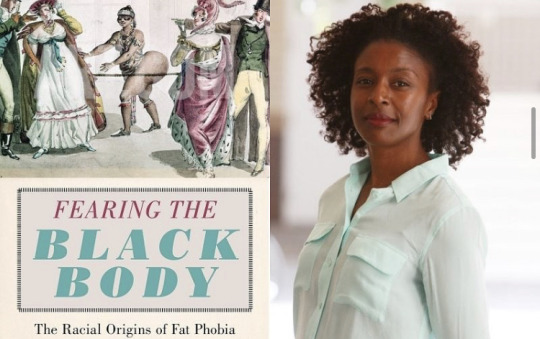
Sabrina Strings is an associate professor of sociology at the University of California, Irvine and the author of Fearing the Black Body: The Racial Origins of Fat Phobia, which exposes fatphobia’s roots in anti-blackness. Strings contributed an opinion story to The New York Times titled “It’s Not Obesity. It’s Slavery.” With Lindo Bacon (creator of HAES), she coauthored “The Racist Roots of Fighting Obesity,” published in Scientific American. Strings has a BA in psychology and an MA and PHd in sociology. This book is #1 on my to-read list!!
https://www.sabrinastrings.com
• Hannah Fuhlendorf (she/her), MA LPCC NCC

Hannah is a highly educated and experienced counselor whose work focuses on self acceptance, eliminating the effects of internalized oppression, and practicing through a HAES lens. She is a fat liberationist who puts out educational videos daily. Hannah is also married to a healthcare professional, and the two of them are working toward making the medical field more accessible to fat people in their local community, and offering education on how to be fat allies. I really admire Hannah and the work that she does!
@ hannahtalksbodies on IG and TikTok
• Tracy Cox (she/her)
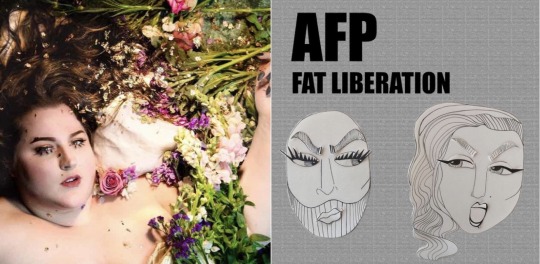
Tracy is an award-winning performer and artist, who co-created the web series “Angry Fat People” with Matthew Anchel, which takes a pop culture approach on serious issues faced by fat performers. She has been interviewed by the New York Times on fat politics and accessibility, and currently has a huge following on IG where she unpacks fat performance, fashion, and politics. You may know her as the creator of the ‘fat vanity’ trend on TikTok!
@ sparklejams on IG & TikTok
• Da’Shaun L. Harrison (they/them)
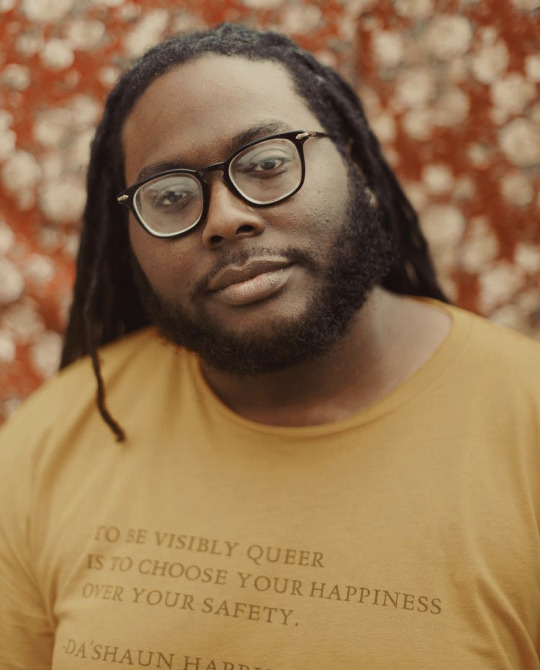
Da’Shaun is a non-binary abolitionist, community organizer, and writer. They are currently a managing editor and columnist at Wear Your Voice Magazine. They travel throughout the United States and abroad to speak at conferences, colleges, and lead workshops focused on Blackness, queerness, gender, class, religion, (dis)abilities, fatness, and the intersection at which they all meet. Da’Shaun is the author of the book Belly of the Beast: The Politics of Anti-Fatness as Anti-Blackness, which is expected to be published in July 2021. They have an incredibly enlightening social media presence as well!!
@ dashaunlh on IG and Twitter
• Lauren Buchness (she/her)
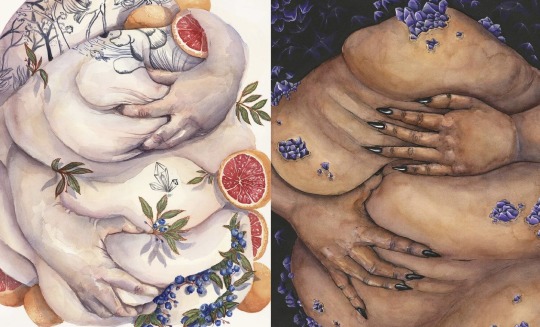
Lauren Buchness is one of my favorite artists. She’s a contemporary artist and fat activist based in Tucson, Arizona. By combining painting & performance, she aims to question Western standards of beauty and create conversations that alter preconceived notions about the fat body. Go check out her gorgeous work!!
@ ladybuchness on IG and TikTok
If you’re interested in learning about diet culture and intuitive eating, check out
Shana Minei Spence (she/her), MS RDN CDN
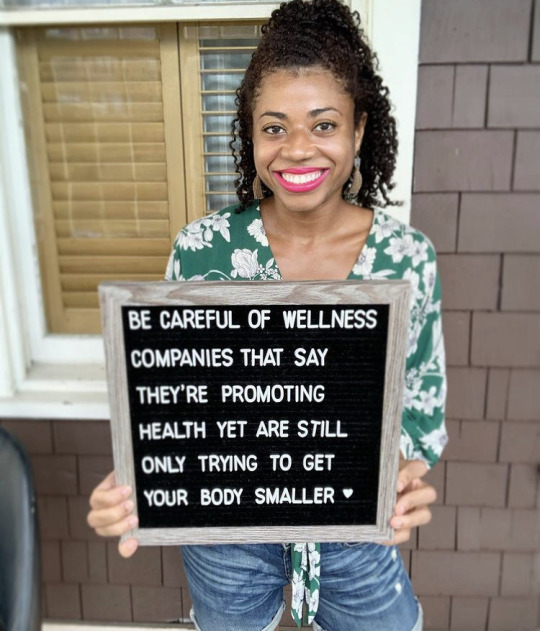
Shana is a Registered Dietitian Nutritionist who opposes food restriction and encourages intuitive eating! She spreads food positive daily messages on her platform. She used to work in fashion, but she left after being dissatisfied with the industry and went back to school to become involved in food policy and public health. She offers counseling on a HAES approach. I have much respect for Shana!
@ thenutritiontea on IG
And right here on tumblr (who was my personal introduction to fat lib) -
@ bigfatscience !!!
An anonymous fat liberationist. They share so many great resources, diving head-first into the scientific research of weight and health, they’ve found that the relation between the two is extremely complex. They tackle the biases of research in a system that profits off of fatphobia, and they offer a fat positive perspective based on scientific studies. Their blog serves as an easily accessible resource for fat folx and fat activists who want to learn about fat positive science to support their own personal interests/activism. Thank you for your work, bigfatscience!! (if you have questions for them, you will have a greater chance of getting a response with anon off!)
• Sonalee Rashatwar (she/they), LCSW MEd
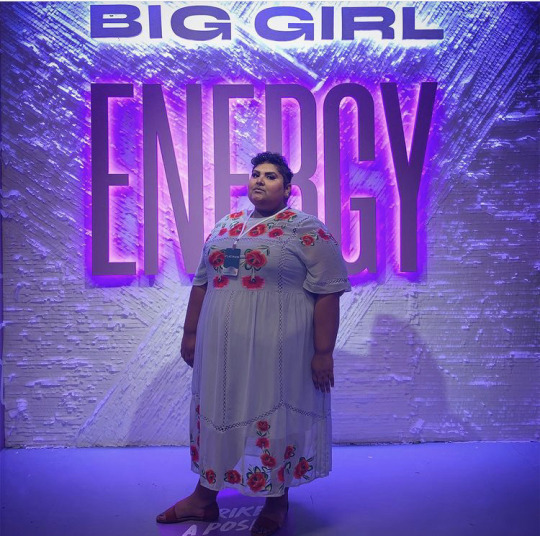
Sonalee is an award-winning clinical social worker, sex therapist, and grassroots organizer. They’re a superfat queer bisexual non-binary therapist and co-owner of Radical Therapy Center. Sonalee is specialized in treating sexual trauma, internalized fatphobia, immigrant kid guilt, and South Asian family systems, while offering fat positive sexual healthcare. Go, Sonalee!!
@ thefatsextherapist on IG
• Fat Rose (org)
Fat Rose organizes fat people, building a more radical fat liberation movement in strong relationship with other social movements, such as anti-fascism, anti-ableism, and anti-racism. Check them out on Facebook!
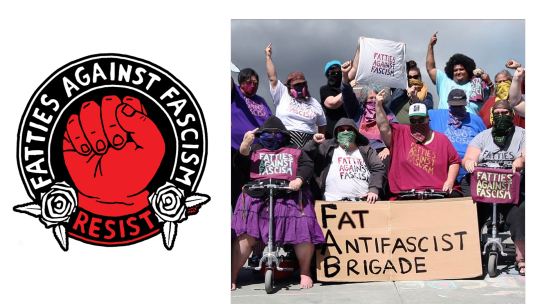
fatrose.org
Honorable IG mentions: (Some anti diet culture specific blogs in here, as well)
@fatangryblackgirl @msgigggles @thefatphobiaslayer @bodyimagewithbri @saucyewest @fatpositivetherapy @fatlippodcast @chairbreaker
BOOKS
And here’s an amazing list of fat-positive book recommendations from HannahTalksBodies!
Science & Health:
Health at Every Size by Lindo Bacon PhD
Body Respect by Lindo Bacon PhD and Lucy Aphramor PhD, RD
Secrets from the Eating Lab by Traci Mann PhD
Anti-Diet by Christy Harrison MPH, RD
Fat Liberation:
Fearing the Black Body by Sabrina Strings PhD
Fat Activism by Dr. Charlotte Cooper
Fat Politics by J. Eric Oliver
The Fat Studies Reader by Esther Rothblum (Editor) and Sondra Solovay (Editor)
Fat Shame by Amy Erdman Farrell
Self Acceptance:
The Body is Not an Apology by Sonya Renee Taylor
Things No One will Tell Fat Girls by Jes Baker
Eating in the Light of the Moon by Anita Johnson PhD
Happy Fat by Sofie Hagan
You have the Right to Remain Fat by Virgie Tovar
Thanks for reading! Please feel free to share this list of resources!
Image descriptions below.
1. [ID: A black and white photo of Bill Fabrey, a straight-sized, balding white man with thick black glasses wearing a suit and tie, standing at a poduim in front of a sign that reads, “NAAFA”. Beside the image is another photo of Fabrey, from his left side.]
2. [ID: A black and white photo of seven fat, female and gender non-conforming members of The Fat Underground, performing a recital.]
3. [ID: The cover of Sabrina Strings’ book, Fearing the Black Body: The Racial Origins of Fat Phobia. On the cover is an illustration of four upper-class white people in fancy colonial period clothing showing shock and disgust at a Black woman’s exposed body. Beside the book cover is a photo of Sabrina Strings, a straight-sized Black woman with dark brown curly hair wearing a blouse.]
4. [ID: Hannah Fulhendorf, a fat, white woman with straight hair dyed blue, wearing a black tank top and holding her shoulder while smiling brightly and looking into the camera.]
5. [ID: An artistic picture of Tracy Cox, a fat, white woman with long, straight brown hair, laying topless on a bed of flowers. There are flower petals placed strategically in her hair on her skin, and along her lower eyelid. Beside that image, is an image of the album cover for Angry Fat People, picturing two angry faces made out of white paper against a grey background. In the top left corner, black, bolded text that reads “AFP” and “FAT LIBERATION”.]
6. [ID: Da’Shaun L. Harrison, a fat, non-binary Black person with a beard, glasses, and long dreadlocks, wearing a shirt that reads, “TO BE VISIBLY QUEER IS TO CHOOSE YOUR HAPPINESS OVER YOUR SAFETY. -DA’SHAUN HARRISON” against a natural backdrop of autumn leaves.]
7. [ID: A watercolor painting by Lauren Buchness of a white and tattooed fat body, hands caressing abstract rolls of fat with wild blueberries and grapefruit between folds. Beside it is another Buchness watercolor painting of Black hands with long sharp nails, caressing the midsection of a fat Black body, with purple crystals growing out of the skin.]
8. [ID: Shana Minei Spence, a straight-sized, Black woman smiling with bright pink lipstick and her long wavy hair pulled back, wearing a floral pattern shirt and jean shorts. She is holding small marquee that reads, “BE CAREFUL OF WELLNESS COMPANIES THAT SAY THEY’RE PROMOTING HEALTH YET ARE STILL ONLY TRYING TO GET YOUR BODY SMALLER” and a heart symbol.]
9. [ID: Sonalee Rashatwar, a superfat, South Asian non-binary person with short black hair, wearing a long floral dress, standing in front of large glowing text that reads, “BIG GIRL ENERGY” against a coarse-textured wall.]
10. [ID: A circular logo with a red fist in the center, with text surrounding it that reads, “FATTIES AGAINST FASCISM” with roses separating the word “RESIST”. Beside it is another image, of eleven fat and superfat activists, standing and sitting on mobility scooters, holding fists and middle fingers in the air, wearing T-shirts and holding banners that both read, “FATTIES AGAINST FASCISM”. In front of the group is a large cardboard sign that spells the acronym “F.A.B.” which stands for “Fat Antifascist Brigade”.]
#fat activists#people#fat liberation#fat activism#fat positivity#resources#anti diet culture#anti-diet#anti-fatphobia#anti-racism#haes#masterpost
2K notes
·
View notes
Link
On January 3, a US drone strike in Iraq killed Iranian general Qassem Soleimani, sparking mutterings of World War III. The next day designer Paria Farzaneh presented her Fall/Winter 2020 collection, centred around the idea of an Iranian wedding ceremony at London Fashion Week Men’s, posing a sharp, positive counterpoint to the conflict in the Middle East.
While Farzaneh might not have been able to predict the political upheaval in the region, her work can be credited with challenging Western perceptions of Middle Eastern aesthetics. Her work draws on her Iranian heritage, with her latest collection refracting it through the lens of utilitarian outerwear melded with traditional patterns. All framed in a hopeful narrative.
“It’s a time to come together, to remember where you come from. Even though I was born here, I have been to Iran every year of my life,’ said Farzaneh on growing up in England. ‘I feel I am doing them proud, speaking for them, and that’s important to me.”
Farzaneh is part of a new crop of menswear designers reinterpreting their Middle Eastern heritage, something that has become increasingly popular with Western audiences.
“There’s a global eye on the Middle East at the moment,” says Tania Fares, founder of Fashion Trust and Fashion Trust Arabia, an annual non-profit organisation which provides financial support and business mentorship from expert panelists to designers in the MENA region. “Many designers are building their brands across the region and internationally, but not all are able to sustain and grow over time and achieve the international recognition they deserve.”
In Tel Aviv, Israel, there is Amit Luzon and Eyal Eliyahu, the duo behind menswear label ADISH which endeavours to deconstruct the tense socio-political dynamics between Israel and its neighbouring countries, in particular Palestine. The work renders traditional patterns and techniques in modern ways with a sharp focus on craft.
The intent wasn’t always political. Multiple industry insiders in Israel advised them against it, Luzon explains. However, injecting politics into their designs was decided upon after Nada, the leader of the group of women that brand works with at the Dheisheh refugee camp in the West Bank, with whom ADISH works on its production. “To hear what the women in the camp have been through in their lives in Palestine, which is only 40 minutes drive away from our studio, was a catalyst for us.”
After two years of working together, the brand opened an independent embroidery workshop in Dheisheh refugee camp. On every piece the brand produces there is a tag with the signature of the women who make the embroidery on the items. “It’s super important for the ladies to credit them and the places they come from,” says Luzon. Today, the brand produces half its collection in Israel (outerwear, weaving and embroidery), the other half in Palestine (tailoring and craft workshops). For Adish, it’s a symbolic way to show peace between the two, at conflict, regions.
“Being in the middle of the conflict here, especially in the current political climate, it’s really hard to feel like you can actually make a difference or change anything,’ said Luzon. ‘We are doing our part by bringing attention to traditional Palestinian craft while also making a difference in the lives of artisans who work with us,” says Luzon
London-based designer Hoor Al-Qasimi hails from the United Arab Emirates. She succeeds her late brother Khalid who passed away in July 2019. Earlier this year she presented her first collection for QASIMI. Each season, the brand produces a flotilla of modern, refined garments — with a focus on military, utility, and streetwear — heavily inspired by a multicultural background of a childhood spent between Sharjah and London.
PreviousNext1 / 2
“I wouldn’t say we aim to challenge Western perceptions, but I feel it’s important, as a brand with a heritage from both sides of the world, to educate [the West] on Middle Eastern values and its unspoken culture. QASIMI aims to do this through being both soft and humble, and not overly forceful,’ says Hoor al Qasimi.
The smatterings of military influence stem from the designer’s upbringing during the Gulf War; albeit far from the conflict, the memories of warfare still last. “All my work is highly emotional and always challenging, whether it’s art or fashion. Khalid was very much the same,” al Qasimi says of her late brother.
Consistent amongst the new crop of designers is a sense of preservation of aspects of their personal heritage — from upbringings between East and West, interest in fabled tales from the region’s past, trips to countries their parents and grandparents grew up in — stories that would otherwise have not seen the light of day.
“This is a time for designers to reclaim their narrative through storytelling,” says Sara Sozzani Maino, Deputy Editor-in-Chief at Vogue Italia, who served as a judge for the inaugural Fashion Trust Arabia ceremony. “For designers now, it’s fundamental to clearly communicate the message they want to give and how they want to create awareness and positive impact in the industry.”
Designers from the Middle East have enjoyed success for years. All from Lebanon, Reem Acra, Elie Saab and Zuhair Murad built flourishing businesses in New York and Paris. Though for all their frothy tulle and delicate embroidery, the new crop of designers are seemingly more questioning and interpretive of their backgrounds.
And they’re succeeding. The international press coverage of designers from the region has boomed in recent years, from Saudi Arabia hosting its first fashion week and the Fashion Trust Arabia drawing a star-studded lineup to Qatar. Furthemore, in 2017, Conde Nast launched Vogue Arabia, following with the launch of GQ Arabia in 2018..
“Working with Fashion Trust Arabia allowed us discover new talent in the region and learn more about what inspires them. Each brand [is] incredibly proud of their heritage and it [is] clear how much this has influenced the way they design and produce their collections,” explainsNatalie Kingham, Fashion and Buying Director at Matches Fashion, which today stocks many brands from the region including Adish and Racil. “From the use of local artisans, to inspiration from ancient artefacts and dress within the region, the intricate detailing and storytelling is so compelling and we find it resonates really well with our customers.”
Yet there is no consensus amongst designers from the Middle East about what reinventing heritage looks like — the MENA region spans approximately 19 countries, each one equipped with its own history, experience, and culture. The designers, in turn, interpret their own heritage and challenge Western perceptions, their own way.
“Just as every country is different, every designer is different, so it’s very difficult to identify Middle Eastern style because the region is so culturally diverse. Our aim is to not necessarily define an “Arab” style, but more so to highlight the wide variety of talent,” says Fashion Trust’s Tania Fares.
Western designers have not always been auspicious in their connections with the East. In 2018, Gucci came under fire for showing a turban in their Fall/Winter 2018 collection. A visible marker of Sikh identity, the brand, and retailer Nordstrom who sold the item, received criticism and accusations of cultural appropriation on social media. It’s up to designers from the region to create the narratives that are true.
“There’s real potential from young Arab designers and Middle Eastern-based labels with the international market,” says Fares. [Now] we’re looking forward to showing it,” says Fares.
3 notes
·
View notes
Text
Sawyer’s Film Review: Sex, Sin and 69
Sex, Sin and 69: Critical Film Review
GNDS 125: Gender, Race and Popular Culture
By Sawyer Bailly (20152498)
Through interviews and monologues from various queer academics, historians, and activists, the documentary Sex, Sin and 69 looks back on the 1969 legislation to “decriminalize” homosexuality and explores the misconceptions surrounding decriminalization and what it meant for the LGBTQ+ community in Canada. Throughout the film, narrator Fawzia Mirza takes the audience through the evolution of the gay rights movement in Canada, including various acts of discrimination by the Canadian government. This narration is accompanied by the voices of multiple contemporary players in the LGBTQ+ community, each of which contribute their own experiences of existing in Canada as well as their perspectives on sexuality and gender. The film also includes coverage of trans and intersex history and struggles, in which it challenges gender norms and binary ways of thinking. Topics such as colonization, Aboriginal history, and racism are also touched on. 69, despite several shortcomings regarding intersectionality and exploring decriminalization in depth, does an excellent job of shedding light on uncomfortable and dark moments in Canadian history- and because of this, it is a must see.
Something that I felt 69 addressed well was the importance of inclusivity- and the fact that this issue was not solved by decriminalization. Early on in the film, an interviewee spoke about his experience as a closeted gay man living in Kingston over twenty years ago and described the solace and sense of community he found in gay bars. He recounted his experiences sneaking in the back door to one of these bars, where he would ring a bell to tell the bartender to let him in. Gay bars were not simply a place to drink and dance: they were places in which people could connect with others with shared or similar experiences and exist unapologetically. In a social climate in which there were very few inclusive spaces for LGBTQ+ individuals, gay bars were where many felt safe and welcome, rather than feeling that their identity was in question or perceived as “abnormal”.
Throughout the rest of the film, the importance of safe spaces continued to be emphasized- places where one need not worry about their identity being questioned or treated as “different”, where they are simply not “in question” (Ahmed 120-21). At a time when gender or sexuality that did not fit with the “norm” of cisgender heterosexuality was violently unaccepted, it was crucial for people who identified as LGBTQ+ (although this terminology did not exist at the time) to find safe spaces within their communities, where there could be constructive discourse about positive change. The Body Politic, a newspaper advocating for gay rights, was presented as an example of an inclusive space. Again, however, decriminalization did not prevent places like this from being targeted by the police force and the public.
Something that 69 fell short in was its time spent on intersectionality. While there were a few discussions regarding intersectionality, such as lasting colonial effects stemming from the treatment of Two-Spirited individuals by the Christian church, these discussions were fairly brief, and the movie remained mainly dominated by “white” movements. After the detailing of the colonizer’s treatment of Two-Spirit Aboriginal people, the film rarely made specific reference to any marginalized groups within the LGBTQ+ community in the years before and after the legislation. The narration scored video clips and photos of white-driven protests and individual players, such as Jim Egan, that did not accurately capture the intersectionality existing in all of these points in the gay rights movement. The privilege that comes along with existing as a white LGBTQ+ individual was hardly acknowledged, in past or present tense, and it seemed as though the filmmakers had not made a significant effort to examine the events leading up to the 1969 legislation, or those shortly after, through an intersectional lens.
It would be incorrect to say that 69 did not touch on intersectionality at all. One of the interviewees, El-Farouk Khaki, spoke about his identity as a gay, Muslim man and his experiences of multiple forms of oppression in unison. Intersectionality was again touched on near the end of the film, in which the marginalization of black LGBTQ+ women was addressed and the movements that have sprung up as a result of this oppression. These were valuable moments in the film that I wish I had seen more of. However, it is safe to say that any examination of social injustice or oppression is incomplete without every aspect being analyzed through an intersectional lens, as it helps us to understand the complexity of oppression in our society (Kaufman)
Another strong point of the film was the time spent on a discussion surrounding intersex individuals, the dangers of binary thinking, and the evolution of the rights of people who are transgender. I felt that the film did an excellent job of challenging gender normativity as well as the cissexism that exists in many aspects of society, such as the genital procedures done non-consensually by doctors on intersex babies.
I believe that the misconceptions surrounding Bill C-150 were handled well. Never was it argued that decriminalization was a cure all for homophobia; most of the interviewees only acknowledged that it was a step in the right direction. Trudeau’s declaration 'there's no place for the state in the bedrooms of the nation', seemed to be revered as a revolutionary statement that changed the game in the gay rights movement and was the catalyst for decriminalization. In terms of explaining the bill itself, the film did an excellent job of detailing its benefits as well as its faults. The overall consensus, however, seemed to be that it was the step that, realistically, was ‘right’ for the time. Before the credits rolled at the end of the film, a brief message appeared explaining that several people had declined to be in the film as they believed that decriminalization was not a positive thing and that the premise of the film was problematic. I would have liked to hear perspectives such as these in greater detail, so that I could have a more multidimensional understanding of decriminalization.
That being said, I would definitely recommend this film for its exposure of a widely unknown chapter in Canadian history, as it is important for everyone to understand events such as these in order to move forward in creating a better future. Despite the fact that, like any other film, it has its shortcomings, it is worth a watch and has many moments of great value to any viewer.
Word Count: 1077 (with in-text citations)
References
Ahmed, Sara. "Being in Question" in Living a Feminist Life. Durham: Duke University Press, 2017.
https://read.dukeupress.edu/books/book/1933/chapter/191590/Being-in-Question
Kaufman, Peter, 2018. “Intersectionality for Beginners.”
https://www.everydaysociologyblog.com/2018/04/intersectionality-for-beginners.html#more
0 notes